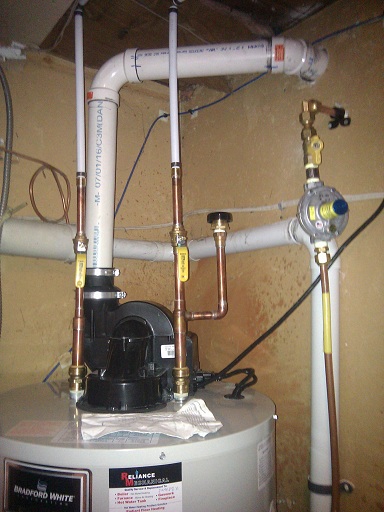Typically they require stainless steel triple wall venting.
Can tankless water heater and furnace share vent.
A high e furnace has separate venting which leaves the existing vent pipe to serve only the water heater.
Your tankless requires it s own individual vent.
Here are a few things your installer should consider for effective tankless water heater venting.
The difference is that a power vent water heater pulls in combustion air from the space around the appliance then uses a fan to propel the exhaust through the vent.
The vent pipe must be made of stainless steel designed for venting corrosive gases.
You furnace vent pipe is probably type b vent and not suitable for this use.
The furnace is likely sized correctly with no room to add another appliance.
Tankless water heaters use fans to blow exhaust from the unit horizontally allowing vents to terminate on the side of a house.
This is because most homes have water heaters and furnace sharing the same exhaust vent.
A direct vent system pulls in.
Best case scenario you kill your furnace.
It would be a potential fire hazard.
The furnace in the photos is a category i appliance a negative pressure draft vent appliance.
However the key here is to install the vent pipe in the size required by the water heater.
Most homes have a shared vent serving both the furnace water heater when the furnace efficiency is up to 80 which is today s standard efficiency gas furnace.
Before you decide against a tankless water heater for your next project consider these tankless water heater venting requirements.
Special stainless steel pipe.
The tankless heater cannot share vent piping with any other appliance and it cannot use a masonry chimney flue for venting.
This unit is a condensing unit and requires a pvc vent so no you can t connect it to the common vent you describe.
Yes venting tankless water heater with furnace is possible.
Facts about tankless water heater venting.
Always follow the manufacturer s installation instructions exactly.
Tankless heaters put out a lot of heat.
Vent to the outside.
Traditional gas tank water heater require venting through the roof.
Tankless water heaters can vent through the roof or a side wall creating more flexibility and options for placement.
Worst case scenario you kill your family.
If you were to tie the vents together the exhaust from the tankless water heater would be pushed through the furnace and into your indoor space.
Gas tankless water heaters don t have to use indoor air for combustion.

